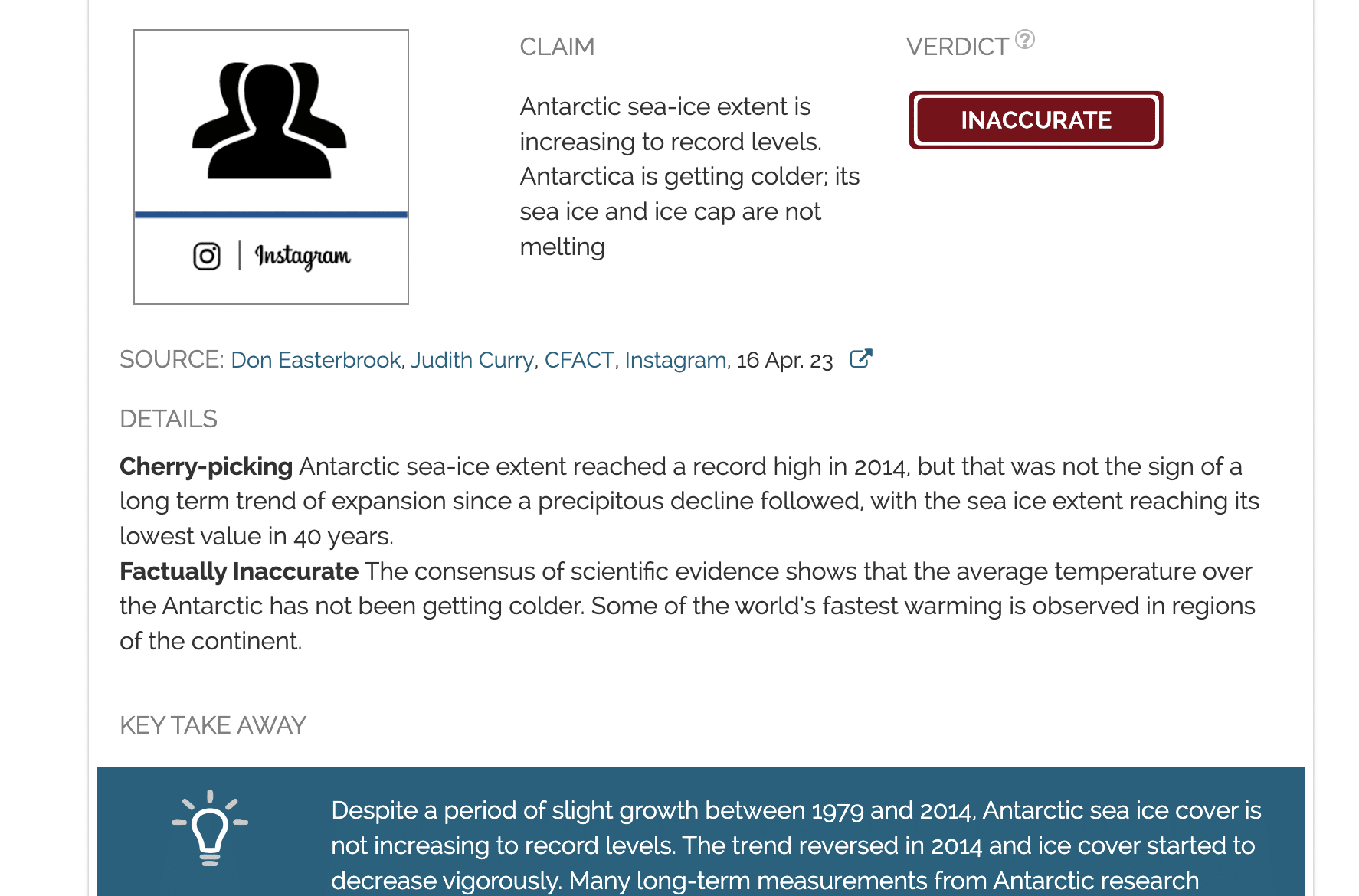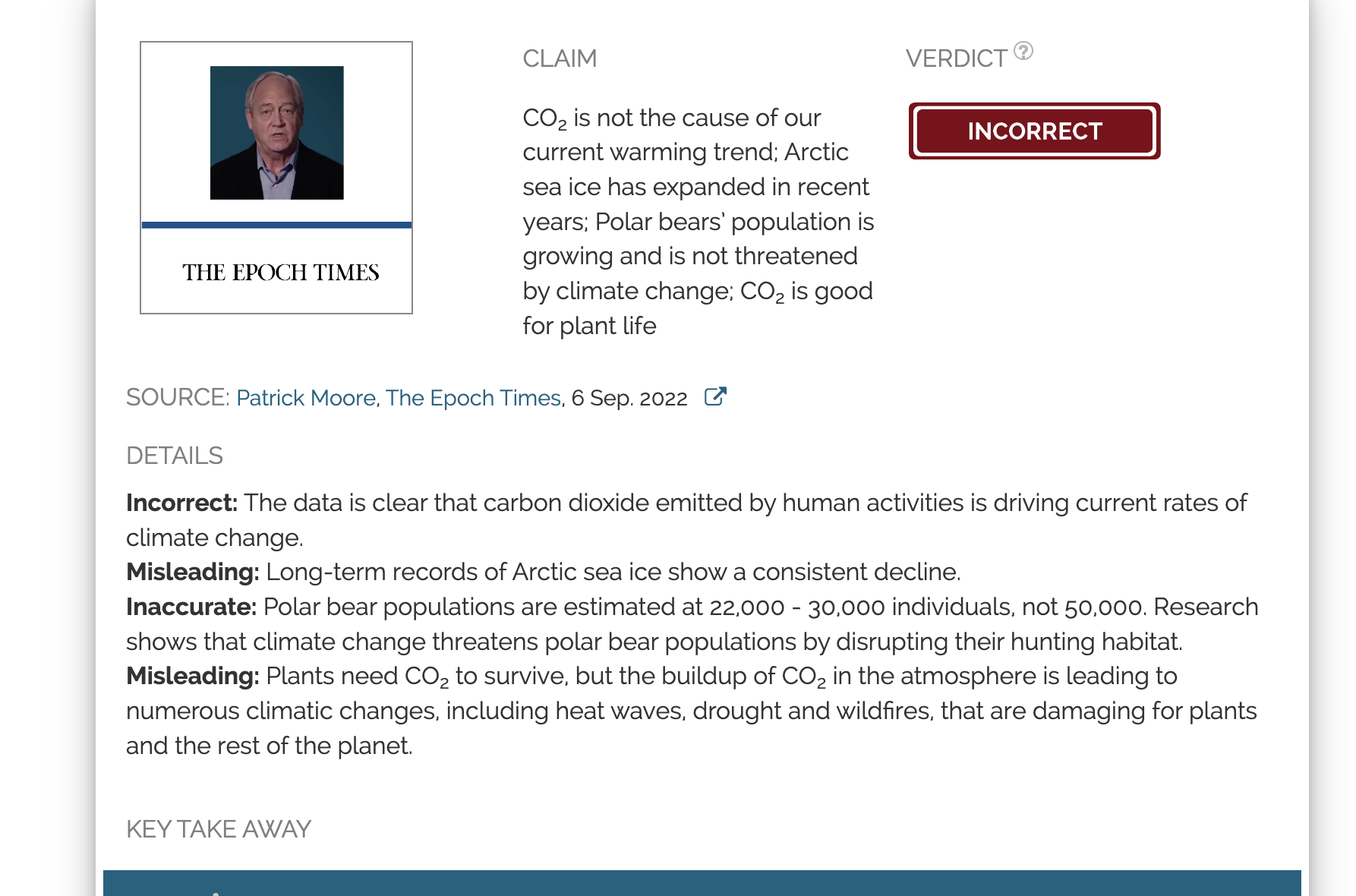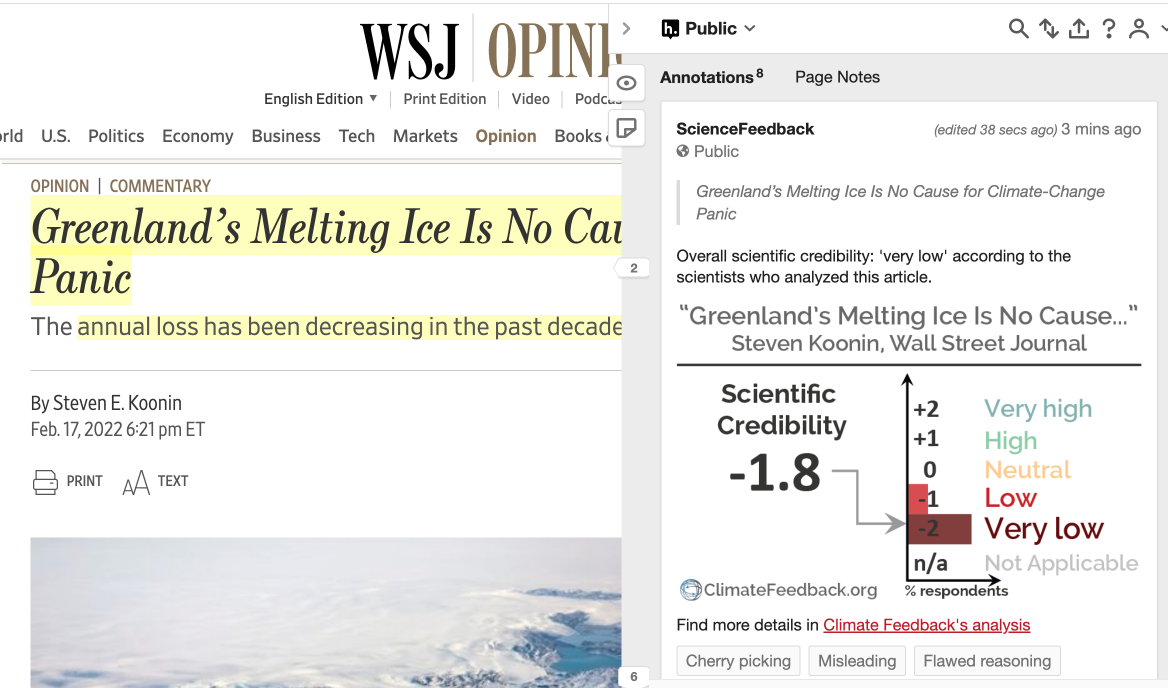- Climate
New York Times series accurately describes research on Antarctic ice sheets and sea level rise, but highlights uncertain studies
Reviewed content
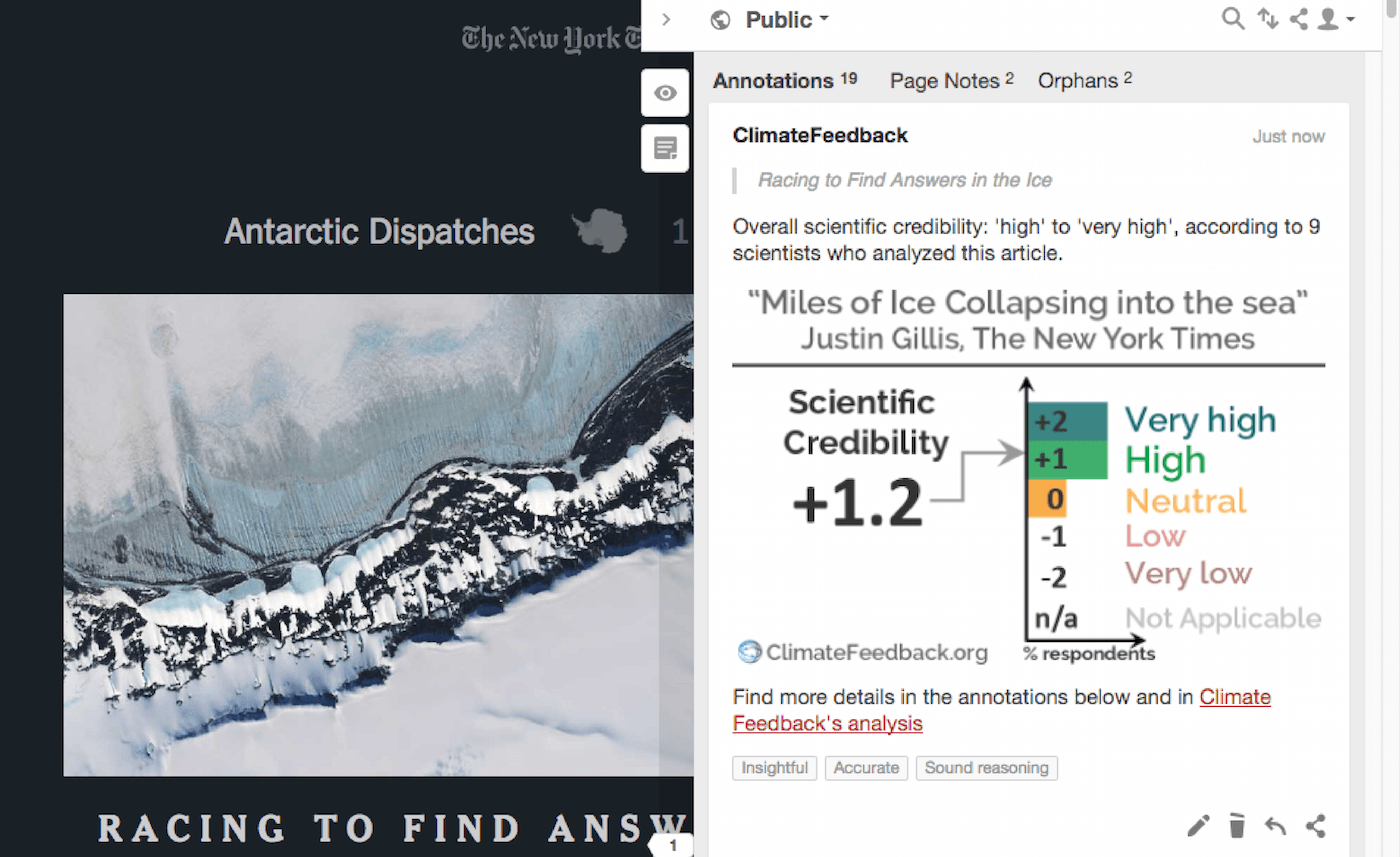
Headline: "Antarctic Dispatches: Miles of ice collapsing into the sea / Racing to find answers in the ice"
Published in The New York Times, by Justin Gillis, on 2017-05-18.
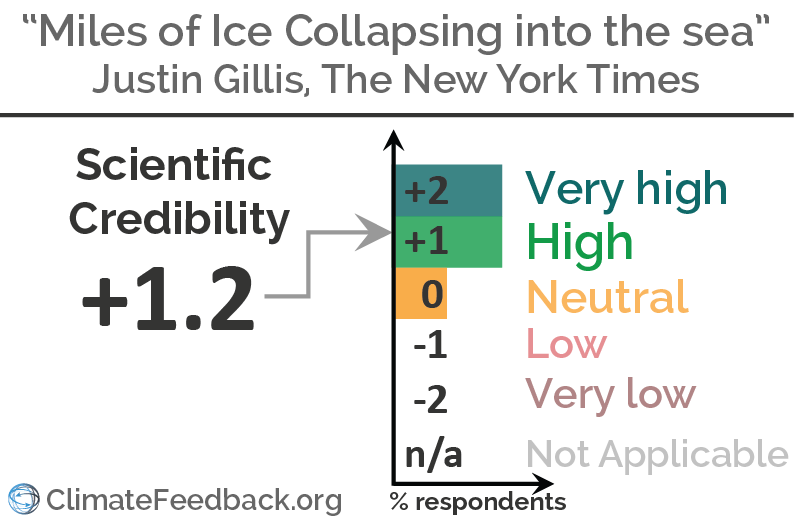
Scientists’ Feedback
SUMMARY
This three-part article in the New York Times describes research on the outlook for Antarctica’s ice sheets and their contribution to sea level rise. Scientists who reviewed the article indicate that it is generally an accurate description of the state of research, which shows that the West Antarctic Ice Sheet (which is especially vulnerable to warming) alone has the potential to raise global sea level by several meters over the long term. However, several complex statements could be improved with additional context or more precise wording to help readers avoid misconceptions. For example, the article relies heavily on recent results from one ice sheet modeling effort that simulates higher future rates of ice melt, while other model simulations contain important differences.
See all the scientists’ annotations in context
REVIEWERS’ OVERALL FEEDBACK
These comments are the overall opinion of scientists on the article, they are substantiated by their knowledge in the field and by the content of the analysis in the annotations on the article.

Postdoctoral Scholar, Geophysical Fluid Dynamics Laboratory, Princeton University
Generally scientifically sound, but caution should be displayed before basing discussion solely on a single modeling study, especially when it incorporates fundamentally different processes relative to other contemporary models.

Professor, Earth Observatory of Singapore
Determining the rates, mechanisms, and geographic variability of sea-level change is vital to projecting future sea-level rise and managing coastal flood risks. Because the Greenland and Antarctic ice sheets have the largest potential to contribute to global mean sea-level rise under future warming, understanding their sensitivity to climate change is of particular importance.

Assistant Professor, University of Colorado, Boulder
This article is well written and contains no logical fallacies. Some statements could be clarified/quantified a bit better.

Assistant Professor, University of Virginia
The Antarctic Ice Sheet has the potential to contribute significantly and rapidly to future sea-level rise. This article accurately and succinctly presents research on the processes and feedbacks that make the scientific community worried about the fate of the Antarctic Ice Sheet in a warming world.

Professor, Met Office Hadley Centre & University of Exeter
The majority of the article is informative and a fair reflection of an important area of scientific research. It is good to inform readers of this. However, in my view, the start and end of the article and the headline give undue prominence to an highly speculative aspect of the story, i.e., the question of whether major loss of ice from Antarctica has already become unavoidable. This distinction between future, avoidable, risks and existing, unstoppable impacts is absolutely key, and while the majority of the article makes this distinction well, the emphasis in the headline and the start and end of the article are opposite to that in the main body of the article.
Notes:
[1] See the rating guidelines used for article evaluations.
[2] Each evaluation is independent. Scientists’ comments are all published at the same time.
Key Take-aways
The statements quoted below are from the article; comments and replies are from the reviewers.
“The acceleration is making some scientists fear that Antarctica’s ice sheet may have entered the early stages of an unstoppable disintegration.”

Postdoctoral researcher, Los Alamos National Laboratory
This is all factually true. Indeed, there is worry that a climatically-initiated dynamic disintegration is currently underway. However, there is also large uncertainty around whether this is the case. So, I would tend to classify scientific confidence on whether current mass change trends represent (in part) a true dynamical disintegration process as “low”.

Assistant Professor, University of Colorado, Boulder
This is true, but referring to West Antarctic ice sheet would be more precise.

Professor, Met Office Hadley Centre & University of Exeter
It is clear that ongoing warming of the climate will pose major risks to the stability of ice sheets. However, this statement seems to have moved the story up a notch from what is actually written later in the article. There are two aspects to this: (1) the size of the area of concern (the whole of Antarctica rather than just parts), and (2) whether irreversible loss has already begun, as opposed to being an imminent risk. The article describes legitimate concerns that parts of the West Antarctic Ice Sheet are becoming vulnerable and hence may soon be at risk of starting an “unstoppable disintegration”, but the suggestion that this is actually already happening (and hence that major Antarctic ice loss is now avoidable) is far more speculative—as indeed the later parts of the article make clear. The phrase “entered the early stages of an unstoppable disintegration” is not the same as “becoming vulnerable to an unstoppable disintegration”, but the latter phrase would better represent what is said later in the article.
“Because the collapse of vulnerable parts of the ice sheet could raise the sea level dramatically, the continued existence of the world’s great coastal cities — Miami, New York, Shanghai and many more — is tied to Antarctica’s fate.”

Assistant Professor, University of Colorado, Boulder
This is the prime motive of understanding Antarctic ice sheet dynamics, especially since the far-field location gives Antarctica relatively more weight to sea level rise along many Northern Hemisphere cities than Greenland.

Assistant Professor, University of Virginia
The vulnerable parts of the ice sheet are those that resting on beds that are below sea level; therefore, the ice itself is in contact with a warming ocean. The majority of the West Antarctic and ~30% of the East Antarctic sectors of the ice sheet are grounded below sea level.
“Remote as Antarctica may seem, every person in the world who gets into a car, eats a steak or boards an airplane is contributing to the emissions that put the frozen continent at risk. If those emissions continue unchecked and the world is allowed to heat up enough, scientists have no doubt that large parts of Antarctica will melt into the sea.
But they do not know exactly what the trigger temperature might be, or whether the recent acceleration of the ice means that Earth has already reached it.”

Postdoctoral researcher, Los Alamos National Laboratory
This is factually true. In principle, there should be threshold in cumulative carbon emissions, beyond which the Earth system is committed to various levels of Antarctic ice loss. These thresholds have been only preliminarily explored, and are still largely unknown. And given the relatively slow response time of the Antarctic ice sheet, we may have already passes some/all of them—meaning that recent observed Antarctic changes reflect, in part, the initiation of large-scale, possibly irreversible, ice loss.
“But as the ice age ended and the oceans warmed, all of them collapsed.”

Professor, University of East Anglia, and Director of Research, Climatic Research Unit
“Collapse” is commonly taken to mean “fail suddenly and completely”, but in the context of ice sheets the scientific use of “collapse” can encompass much longer timescales (even multiple centuries) and it would be informative to make this clear. For example, IPCC AR5 WGI (Chapter 13 on sea level change) use it this way:
“Future climate forcing could trigger such an unstable collapse, which may then continue independently of climate. This potential collapse might unfold over centuries for individual bedrock troughs in West Antarctica and sectors of East Antarctica.”
Without this clarification, “collapse” may be misinterpreted to mean something happening over timescales of a single decade or much shorter timescales—especially when combined with earlier language about refugees “fleeing inland” due to a “rapid disintegration”.
“The warmer water seems to be doing the most damage to a series of glaciers that flow into a region of West Antarctica called the Amundsen Sea. Satellites have identified the most rapid loss of ice there, raising a critical question: Has an unstoppable collapse of the ice sheet already begun?”

Postdoctoral researcher, Los Alamos National Laboratory
This is factually correct: this is a question that the research community is currently working hard to answer.
“Already, scientists know enough to be concerned. About 120,000 years ago, before the last ice age, the planet went through a natural warm period, with temperatures similar to those expected in coming decades.
The sea level was 20 to 30 feet higher than it is today, implying that the ice sheets in both Greenland and Antarctica must have partly disintegrated, a warning of what could occur in the relatively near future if the heating of the planet continues unchecked.”

Professor, University of East Anglia, and Director of Research, Climatic Research Unit
Although factually correct, the information provided is not sufficient to convey the relevance of sea level during this previous warm period (the previous interglacial) to the current global warming situation. It is not directly analogous because of differences in the Earth’s orbit and the long timescale during which the ice sheet melt was exposed to the warmer temperatures. IPCC AR5 WGI Summary for Policy Makers section B4 notes these two relevant issues: “This change in sea level occurred in the context of different orbital forcing and with high-latitude surface temperature, averaged over several thousand years, at least 2°C warmer than present”.

Postdoctoral researcher, Los Alamos National Laboratory
This is factually correct. Indeed, past climate states analogous to the state which is expected to manifest in the near future, are characterized by much higher sea levels. This implies that the current Antarctic (and Greenland) ice sheet volumes are not consistent with warmer climate states. Rather, warmer climate states are consistent with smaller ice sheets.
“Relatively near future” is probably a misleading statement in the text, because it implies to average people a decadal timeframe—almost certainly unrealistic for 20-30 ft of sea level rise.

Postdoctoral Scholar, Geophysical Fluid Dynamics Laboratory, Princeton University
Sea level and temperatures were higher in the previous interglacial, but the Earth climate system generally had a longer time frame to adjust to these conditions.
“The Ross shelf helps to slow the flow of land ice from Antarctica into the ocean. Compared with other parts of Antarctica, the shelf seems stable now, but computer forecasts suggest that it might be vulnerable to rapid collapse in the next few decades.”

Assistant Professor, University of Virginia
Using the geological record of Antarctic Ice Sheet behavior, the Ross Ice Shelf has collapsed in the past1, likely in response to ocean and atmosphere warming. Therefore, we know that the Ross Ice Shelf, which currently protects large portion of the Antarctic Ice Sheet2, is susceptible to collapse.
- Yokoyama et al (2016) Widespread collapse of the Ross Ice Shelf during the late Holocene, PNAS
- Fürst et al (2016) The safety band of Antarctic ice shelves, Nature Climate Change
“In the scientists’ worst-case computer simulations, continued global warming will cause the Ross Ice Shelf to weaken and collapse starting as early as the middle of this century.”
This collapse in the referenced work is initiated by strong surface melting causing ice shelf hydrofracture and then marine ice cliff instability. Other recent studies looking at the evolution of surface melt in Antarctica find far more modest (likely insignificant) increases in surface melt over this century, particularly over the Ross ice shelf.
“Right now, the shelf works like a giant bottle-stopper that slows down ice trying to flow from the land into the sea. If it collapses, the ice could flow into the ocean more rapidly, an effect that has already happened on a much smaller scale in other areas of Antarctica.
The most vulnerable parts of the West Antarctic ice sheet could raise the sea level by 10 to 15 feet, inundating many of the world’s coastal cities, though most scientists think that would take well over a century, or perhaps longer. They are worried about a possible rise of as much as six feet by the end of this century.”

Professor, University of East Anglia, and Director of Research, Climatic Research Unit
This is correct but unclear. What is “perhaps longer” than “well over a century”? Given the importance of timescale for how coastal cities will respond to sea level rise, the range of possible timescales should be more explicit. IPCC AR5 WGI Chapter 13 on Sea Level Change assesses these as “sea level rise of 1 to 3 m per degree of warming is projected if the warming is sustained for several millennia (low confidence)”.

Lecturer, Bangor University, Wales, UK
Several glaciers that had previously been buttressed by the Larsen B ice shelf accelerated by a factor eight after said ice shelf disintegrated. The demise of this ice shelf lead to an increase of 27 km3 of ice loss per year*.
- Rignot et al (2004) Accelerated ice discharge from the Antarctic Peninsula following the collapse of Larsen B ice shelf, Geophysical Research Letters
“But the story is not straightforward, and the warmer water attacking the ice has not been linked to global warming — at least not directly. The winds around the continent seem to be strengthening, stirring the ocean and bringing up a layer of warmer water that has most likely been there for centuries.
Are those stronger winds tied to human-caused global warming? Some scientists think so, but others say the case is unproven. “We’re not sure because we don’t have enough data, for long enough, to separate signal from noise,” said Eric J. Steig, a scientist at the University of Washington who has studied temperature trends in Antarctica.”

Postdoctoral researcher, Los Alamos National Laboratory
This is factually correct, and an important point. In some climate analyses (such as global average air temperature), climate scientists and statisticians can (1) clearly detect a signal rising above the ‘background’ noise of natural climate variability and (2) clearly attribute this signal to human forcing (versus sun strength changes, volcanoes, cosmic rays, etc.). However, in the case of regional Antarctic climatology, this is not yet clearly the case. Particularly in the case of Antarctic oceanography, as Dr. Steig points out, this largely stems from lack of observations of sufficient length to allow for robust statistical detection/attribution of near-Antarctic ocean changes.
“Recent computer forecasts suggest that if greenhouse gas emissions continue at a high level, parts of Antarctica could break up rapidly, causing the ocean to rise six feet or more by the end of this century. That is double the maximum increase that an international climate panel projected only four years ago.
But those computer forecasts were described as crude even by the researchers who created them. ‘We could be decades too fast, or decades too slow,’said one of them, Robert M. DeConto of the University of Massachusetts, Amherst. ‘There are still some really big question marks about the trajectory of future climate around Antarctica.’”

Professor, Earth Observatory of Singapore
Process-based predictions of sea-level rise by the International climate panel (i.e., the IPCC) are limited by uncertainties surrounding the response of the Greenland and West Antarctic ice sheets1, 2, 3, steric changes4, 5, contributions from mountain glaciers6, as well as from groundwater pumping for irrigation purposes and storage of water in reservoirs7, 8, 9. In large part because of the limitations of physical process models, IPCC AR5 does not offer “very likely” (5th to 95th percentile) sea-level projections, but concluded that “there is currently insufficient evidence to evaluate the probability of specific levels above the assessed likely range”10.
The contribution from Greenland (GrIS) and Antarctic (AIS) Ice Sheet mass loss has increased since the early 1990s, comprising ~19% of the total observed rise in GMSL between 1993 and 2010 and ~40% of the total observed rise in GMSL between 2003 and 200811, 12. GrIS and AIS contributions are projected to become increasingly important over the 21st century10 and dominate sea-level rise uncertainty in the second half of the 21st century13, 14.
- 1- Pfeffer et al (2008) Kinematic Constraints on Glacier Contributions to 21st-Century Sea-Level Rise, Science
- 2- Pritchard et al (2012) Antarctic ice-sheet loss driven by basal melting of ice shelves, Nature
- 3- Rignot et al (2011) Acceleration of the contribution of the Greenland and Antarctic ice sheets to sea level rise, Geophysical Research Letters
- 4- Domingues et al (2008) Improved estimates of upper-ocean warming and multi-decadal sea-level rise, Nature
- 5- Marcelja (2010) The timescale and extent of thermal expansion of the global ocean due to climate change, Ocean Science
- 6- Raper and Braigthwaite (2009) Glacier volume response time and its links to climate and topography based on a conceptual model of glacier hypsometry, The Cryosphere
- 7- Konikow (2011) Contribution of global groundwater depletion since 1900 to sea-level rise, Geophysical Research Letters
- 8- Pokhrel et al (2012) Model estimates of sea-level change due to anthropogenic impacts on terrestrial water storage, Nature Geoscience
- 9- Wada et al (2012) Past and future contribution of global groundwater depletion to sea-level rise, Geophysical Research Letters
- 10- IPCC (2013) Climate Change 2013: The Physical Science Basis. Contribution of Working Group I to the Fifth Assessment Report of the Intergovernmental Panel on Climate Change
- 11- Cazenave et al (2009) Sea level budget over 2003–2008: A reevaluation from GRACE space gravimetry, satellite altimetry and Argo, Global and Planetary Change
- 12- Helm et al (2014) Elevation and elevation change of Greenland and Antarctica derived from CryoSat-2, The Cryosphere
- 13- Kopp et al (2014) Probabilistic 21st and 22nd century sea-level projections at a global network of tide-gauge sites, Earth’s Future
- 14- Cornford et al (2015) Century-scale simulations of the response of the West Antarctic Ice Sheet to a warming climate, The Cryosphere

Postdoctoral researcher, Los Alamos National Laboratory
I think this statement is also factually true. Indeed, recent simulations suggest that sea level rise from Antarctica could be very large. However, as is implied by the word “crude”, these state-of-the-art simulations are still lacking in important physical processes which are very difficult to implement at sufficient resolution in computer models of both the Antarctic Ice Sheet and near-Antarctic climate. So, due to these deficiencies, frankly there is still very large uncertainty regarding upcoming Antarctic change, at least as simulated by computer models. However, paleoclimate proxies have the ability to provide additional critical non-model-based constraints.

Postdoctoral Scholar, Geophysical Fluid Dynamics Laboratory, Princeton University
The “recent computer forecasts” referenced here likely refer to the numerical model developed by Rob DeConto1. Different from other ice-sheet models it includes the so-called “Marine Ice Cliff Instability”, which at present is not widely accepted in the ice-sheet modeling community. Including this instability will cause increased rates for resultant sea-level rise projections. On the other hand, DeConto’s model includes simplifications related to how ice sheet slides over the sediment at the base. This ice-sliding parameterization will generally increase ice-sheet stability and cause smaller projections of sea-level rise, as demonstrated in the Nature paper by C. Ritz et al. in 20152.
There is still a lot of uncertainty regarding the physical and hydrological processes involved in ice-sheet modeling. Ideally, we prepare for the upper bounds regarding projected rates in sea-level rise, since the scientific community is still far from providing high-confidence estimates.
- DeConto and Pollard (2016) Contribution of Antarctica to past and future sea-level rise, Nature
- Ritz et al (2015) Potential sea-level rise from Antarctic ice-sheet instability constrained by observations, Nature

Lecturer, Bangor University, Wales, UK
This is based on a combination of observations and modelling1. Observations show us several glaciers are in decline2 and ice shelves, which serve as a buttress for the glaciers, are thinning due to warmer sea water. This process is seen to be accelerating3. Where ice shelves (like Larsen B) have already vanished, glaciers in the hinterland have indeed sped up4. Numerical models predict that the changes underway now are likely to lead to a full-scale collapse of the west Antarctic Ice Sheet.
- 1- Joughin et al (2014) Marine Ice Sheet Collapse Potentially Under Way for the Thwaites Glacier Basin, West Antarctica, Science
- 2- Rignot et al (2011) Acceleration of the contribution of the Greenland and Antarctic ice sheets to sea level rise, Geophysical Research Letters
- 3- Paolo et al (2015) Volume loss from Antarctic ice shelves is accelerating, Science
- 4- Scambos et al (2004) Glacier acceleration and thinning after ice shelf collapse in the Larsen B embayment, Antarctica, Geophysical Research Letters

Professor, Met Office Hadley Centre & University of Exeter
This reflects recent research—an important point is that this is about possible future consequences of high emissions, which are hence avoidable if emissions are lower. This is in contrast to the opening sentence and headline, which talk of “unstoppable disintegration” already in progress.
“Incorporating recent advances in the understanding of how ice sheets might break apart, they found that both West Antarctica and some vulnerable parts of East Antarctica would go into an unstoppable collapse if the Earth continued to warm at a rapid pace.
In their worst-case scenario, the sea level could rise by six feet by the end of this century, and the pace could pick up drastically in the 22nd century. Dr. DeConto and Dr. Pollard do not claim that this is a certainty — they acknowledge that their analysis is still rough — but they argue that the possibility should be taken seriously.”

Postdoctoral researcher, Los Alamos National Laboratory
This is factually true. I think the text is accurate in reflecting the distinct possibility of “upper-bound” Antarctic behaviour. However, note that the current “worst-case” scenario estimate is not the same as the current “most-likely” scenario estimate (in any risk assessment exercise).

Postdoctoral Scholar, Geophysical Fluid Dynamics Laboratory, Princeton University
Related to my earlier comment, the relevance of the “Marine Ice Cliff Instability” is still very unclear, and not generally accepted in the ice-sheet modeling community. DeConto and Pollard’s sea-level estimates certainly fall in the high end of sea-level rise projections. However, other processes such as non-linearities in melt or basal sliding may provide similar high-end estimates.
“But some research suggests that a catastrophe might not yet be inevitable. In a study last year, Robert M. DeConto of the University of Massachusetts, Amherst, and David Pollard of Pennsylvania State University used their computer model to predict what would happen if emissions were reduced sharply over the next few decades, in line with international climate goals.
Under the most ambitious scenarios, they found a strong likelihood that Antarctica would remain fairly stable.”

Professor, Met Office Hadley Centre & University of Exeter
To my mind, the way this is written gives the impression that the DeConto and Pollard study is the outlier and that a substantial body of research suggest that a catastrophe is already inevitable—however, the article has not actually given any details of any such research, it only raised the possibility of unstoppable disintegration as a research question. It would be far more accurate to say that the vast majority of research does not suggest that a catastrophe is inevitable.

